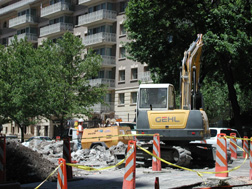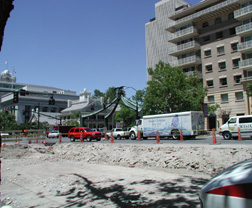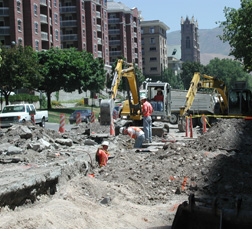Salt Lake City Reconstructs South Temple Street
Improvements made to the utilities as part of the reconstruction project.
July 19, 2002
|
Construction began in the spring of 2002 and will continue through the fall of 2003. When completed, South Temple will once again be the "grandboulevard" of Salt Lake City.
Project Funding
Over $9.6 million of Federal funds are being used to rebuild the road portion of the South Temple. Additionally, over $2.1 million will be paid by Public Utilities for the utility replacements.
Project Scope
In addition to the street elements of this project, (which include complete reconstruction of the surface) major utility improvements will be made. The project will add capacity to the existing storm drain system and improve roadway drainage. Repairs will also be made to the existing sewer system. New culinary waterlines will be installed on both sides of the street from Main Street to Virginia Street.
Historical Description
South Temple Street, formerly known as Brigham Street, was the major east-west road running along the south side of Temple Square in Brigham Young’s gridiron plan of Salt Lake City. Some of the first public utilities were installed in this street.
Brigham Young built his first houses on South Temple beginning with the White House in 1848, the Beehive House in 1854, and the Lion House in 1856. Young gave land grants to other church leaders to build homes along South Temple. Originally there were only one or two buildings per block on South Temple. As South Temple became a desirable residential area, commercial development began to concentrate along Main and State Streets. Over time commercial buildings have replaced most of those historic dwellings. By the 1870s, the railroads brought more non-Mormons to Salt Lake City, as well as a variety of new building materials to create homes along South Temple. South Temple was a major thoroughfare and many laborers walked back and forth along the street to work during the forty-year temple construction project. Horse-drawn fire engines could be seen at the fire station at 400 East South Temple. Although Brigham Young died in 1877, his prediction that Brigham Street would “eventually be the fine residence street of the city” was becoming a reality.
|
The Jordan and Salt Lake Canal runs along the south side of the street from 300 East to State Street. It was completed in 1882. Originally, the idea was to construct a canal to “float” granite slabs from Little Cottonwood Canyon to the temple site. The existing canal was never used for that purpose; but rather it was used to deliver irrigation water from the Jordan Narrows to City Creek. It still exists under South Temple as a 36-inch diameter brick pipe that is used today for storm drainage.
South Temple was not paved until about 1907. Water and sewer were installed prior to paving. The waterlines were made from pit cast iron pipe and the sewer lines of clay pipe. Some of these pipelines have been in the ground for over 100 years. The trenches for these original water and sewer lines were hand dug. At this same time a trolley line ran down the center and was bordered by stone blocks with concrete gutters and sandstone curbs.
The next major street improvement happened in 1928 when Salt Lake City became one of the earliest cities to introduce the “trackless trolley.” Other improvements along South Temple in 1928 included adding a number of light brackets to the old “trolley poles.” In the 1930s a “Pedestrian Subway” was built underneath the roadbed in front of the Wasatch Elementary School at R Street, thus connecting the school on the north with the schoolyard located on the south side of South Temple.
South Temple Historic District was listed on the National Register of Historic Places in 1982.
A more complete history of South Temple Street can be found on the City’s project web site: http://www.southtempleconstruction.com/hist_feat/description.html


